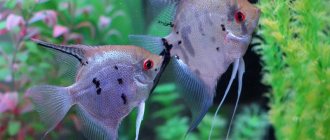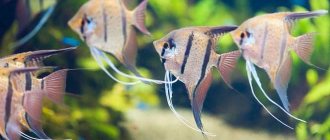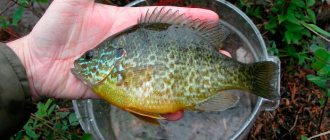Angelfish are the most popular aquarium representatives of the cichlid family. Their lack of bright natural coloring is compensated by the beauty of their long fins and unusual body shape. Angelfish floating in the water seem to float in weightlessness, and their long wing fins support them. With their sophisticated appearance, these “angel fish,” as they are nicknamed abroad, make a stunning impression.
Angelfish have a peaceful nature, making them compatible with many other types of non-aggressive fish. It is not surprising that they have gained popularity among many aquarium hobbyists.
Angelfish, how to distinguish a female from a male
Angelfish, how to distinguish a female from a male is a rather difficult question even among experienced aquarists, let alone novice hobbyists.
In this article we will analyze in detail, using examples with photos, all the differences between the two sexes of angelfish. We immediately warn you that the differences below are suitable for all types and breeds of this wonderful aquarium fish. to accurately determine the sex of an angelfish only at the age of one year, when the fish is fully formed and ready for spawning, so if you buy very young fish from a pet store, then no one will give you a 100% guarantee that this is a future pair of spawners. The second interesting nuance is that in the absence of males, a pair of two females can form and they will even begin to spawn, but this will be of no use, and an inexperienced aquarist will be misled and begin to look for the reason for the eggs not ripening, in conditions keeping and feeding fish.
The first visible difference between males and females is the convex forehead, you can pay attention to the photo below. Males have a convex forehead, while females have a flatter forehead. It happens that in some males the bump on the forehead does not protrude too much and they can be mistaken for females. Be careful when looking for this sign. On the left is the forehead of a male, on the right of a female.
The second sign is the bifurcation of thin ventral fins, which are present only in males. This sign is more difficult to notice, but its presence will definitely let you know that this is a male specimen. The photo below shows the split pelvic fins of the male on the left side, and the straight fin of the female on the right.
The third sign is the shape of the ovipositor, which is located on the abdomen of the fish between the ventral and anal fins. The male has an ovipositor, or rather the vas deferens, pointed and thin; in females it is wider and larger. The problem is that it is very difficult to discern this difference and in different individuals the ovipositor can be of different sizes, as well as the vas deferens, which makes it difficult to determine exactly who it belongs to, a female or a male. In the photo on the left is a male, on the right is a female. The sex of a fish can be determined by this characteristic during the spawning period.
It is much more difficult to distinguish the sex, but it is possible, based on the body shape of adult fish. The profile of males is larger and has more rounded edges in females opposite. In the picture, on the left is a female and on the right is a male.
It is believed that it is possible to distinguish fish by their body pattern, but due to the fact that at the moment there are many breeding varieties that are very different from each other in color, therefore each species must be considered separately. Good luck in keeping and breeding angelfish.
Matching
Experienced aquarists recommend the following: when purchasing adult fish, you should give preference to fish with typical characteristics, or purchase a ready-made pair right away. If you plan to buy small fish, then buy 8-10 angelfish fry with extensive and long fins, which will be divided into pairs.
A pair of angelfish is found on its own, and aquarists prefer not to interfere in this process. However, if you wish, you can select partners personally, for which two fish of the same size and age are placed in the same body of water. After a while, the two angelfish get used to each other and form a pair. There is a strict rule regarding newly formed couples: the couple is not separated, otherwise both halves will experience stress and will not soon decide to start a new family. You can determine the existing couple by their behavior:
- The two fish stay together without swimming far from each other.
- The male begins to chase the female, driving the fish into the corners of the tank.
Angelfish: how to distinguish a female from a male
Angelfish are the most popular aquarium representatives of the cichlid family. Their lack of bright natural coloring is compensated by the beauty of their long fins and unusual body shape. Angelfish floating in the water seem to float in weightlessness, and their long wing fins support them. With their sophisticated appearance, these “angel fish,” as they are nicknamed abroad, make a stunning impression.
Angelfish have a peaceful nature, making them compatible with many other types of non-aggressive fish. It is not surprising that they have gained popularity among many aquarium hobbyists.
General information
According to modern classification, there are three types of angelfish:
The common angelfish (Pterophyllum scalare) is a classic form of angelfish, its natural color is silver with characteristic transverse stripes (usually 4 of them).
Altum angelfish (Pterophyllum altum) - distinguished by a very elongated body and fins, the size of some individuals reaches 50 cm in height;
Leopold's angelfish (Pterophyllum leopoldi) is one of the small species of angelfish, a characteristic feature is a large black spot under the dorsal fin.
Over the years, various color variations have been developed. The last to be bred were the genetically modified GLO angelfish, which contains the genes of marine coelenterates and has a bright, fluorescent color.
Breeding angelfish
Obtaining offspring from angelfish at home is a process that requires certain knowledge and preparation. These fish are not distinguished by their displays of great care for their offspring; sometimes they are prone to eating their eggs.
Before breeding, mature fish are fed with live food . For spawning you need to create the appropriate conditions:
- the temperature in the aquarium is higher than usual - about 28 °C;
- live food;
- fresh water in the aquarium;
- presence of males and females
During spawning, the female can lay 300-700 eggs. Angelfish eggs are laid on plant leaves or other objects in the aquarium. After 3 days the fry will appear. And in about a week, small angelfish will learn to swim.
Preparing for spawning
For successful breeding of fish, the conditions for feeding and keeping cichlids must be observed. It should be immediately noted that fish can spawn both in a general aquarium and in a hatchery, however, to save eggs and keep the fish calm, it is better to prepare the spawning container in advance. Of particular importance for fish spawning is:
- Temperature – fish are kept at a temperature not lower than 27C, gradually increasing the number of degrees to 29-30C, thereby initiating spawning. At the same time, frequent water changes are performed, renewing 10% of the liquid volume 3-4 times a week. If angelfish are kept in hard water, then it is advisable to reduce the hardness.
- Nutrition - The type and quality of food greatly influences the fish's ability to produce viable offspring. Throughout their lives, future parents are fed live food: daphnia, bloodworms, and tubifex. Angelfish raised on dry food are sometimes unable to lay healthy offspring.
Fish reach sexual maturity at 6-12 months. Before spawning, the couple must be kept together, since the males are ready to fertilize angelfish eggs only in the presence of a female. Under favorable environmental conditions, angelfish spawn every two to three weeks, provided that the eggs are removed from the reservoir.
It is advisable to plant vegetation with strong leaves in the spawning tank, and be sure to place a piece of plastic, tile or something durable, since the fish lay their eggs on a hard surface. If this is not done, the angelfish will lay eggs on the filter or the wall of the tank, after which it will be difficult to move the eggs into the incubator.
How to distinguish a male from a female
Those who plan to breed these wonderful fish in a home aquarium sooner or later face the question: how to determine who is male and who is female?
It is sometimes difficult even for an experienced aquarist to distinguish a male from a female angelfish. The fact is that in these fish, sexual differences are not clearly expressed , and in young fish they are almost absent. If you still need to find out the gender of an angelfish when purchasing, you should focus on the size: the largest fry are more likely to be males, and the smallest ones to be females.
Determining the sex of angelfish requires experience and practice. Therefore, beginners may have difficulties. Only by carefully observing your pets, comparing them and noting features of appearance and behavior, can you learn to distinguish females from males.
External gender differences
Angelfish are long-lived aquarium fish: their life expectancy reaches 10 years, sometimes more. In this case, they reach sexual maturity at the age of 7-12 months. Before this time, it is almost impossible to recognize females and males.
When determining the sex of adult angelfish, you need to pay attention to the main differences in the appearance of the male and female:
- Males are usually larger in size than females of the same age.
- Pay attention to the frontal part of the head: males have a forehead with a pronounced fatty tubercle and are convex, while females have a sunken forehead.
- The dorsal fin of males is longer, and in its rear part you can count 7-8 light and dark stripes. The female has fewer stripes - only 5-6.
- In males the front fin has forked ends, in females it is smooth.
- Males have a more clearly defined pectoral keel.
- If you observe angelfish during spawning, you can find another difference. Males have a narrow and sharp vas deferens, while females have a wide and short ovipositor. Before spawning, these differences are almost impossible to observe.
- In a female preparing to breed, the abdomen looks more rounded due to the eggs maturing in it.
- In the male, the back line and dorsal fin form an angle, and the abdomen and anal fin form an almost straight line. In the female, everything is the opposite: the line of the back forms an almost straight line with the fin, while the abdomen with the anal fin forms an almost right angle.
Many experienced aquarists tend to consider the last difference to be perhaps the most reliable.
Another way can help beginners . Among the fish, you need to select an individual in which the signs of sexual dimorphism are most clearly expressed, and use it as a guide when determining the sex of other angelfish.
If you have a goal to start breeding these fish yourself, but have difficulties determining their gender, the best option would be to buy an already formed pair. It’s good if this couple has already given birth to offspring.
Raising and caring for fry
Beginning aquarists are worried, wondering: the angelfish have laid eggs - what to do, and they are completely justified in worrying. Despite the protection of their offspring, angelfish remain exemplary parents for two to three days, after which the fish’s instinct disappears.
If the eggs are laid in a general aquarium, then the future fry are moved to a hatchery - an incubator. They do this in order to preserve the eggs and protect them from attacks by other fish and parents. When transporting eggs, an important rule should be observed: the eggs should not be in contact with air for even a second, otherwise the aquarist’s efforts will be wasted. Therefore, for transportation, a container or cup is used, which is immersed in a reservoir and an object with caviar is transferred into it, and then transported to a separate container.
Conditions for the development of eggs:
- Methylene blue or another drug with a similar effect is introduced into the incubator water to avoid fungal infections.
- The eggs are placed at a distance of 2 cm from the aerator so that no bubbles get on the eggs, but the eggs are washed by a slight current.
- Water for the incubator is taken from the aquarium where the spawning took place. Liquid temperature is about 30C.
- Lighting is set to moderate and around the clock.
The eggs in the tank should be closely monitored: during the development process, aquarists remove whitened eggs with a needle or tweezers, otherwise they will provoke negative consequences for the remaining larvae. After 2-3 three larvae are formed from the eggs, and on the 6th day - fry. Depending on the variety of parents, the transformation process takes from 6 to 12 days.
From the moment the fry appear, it is necessary to start feeding the babies 5-6 times a day. Live dust or nauplii are used as food for angelfish fry, gradually transferring the fish to daphnia, bloodworms and ciliates. As the fish grow, they are moved into containers, the capacity of which is determined at the rate of 4.5 l/1 fish.
Reproduction of angelfish in a home aquarium is an interesting and exciting activity that will not leave the owner indifferent. Do not be upset if the first attempt is not successful - under favorable conditions, angelfish are able to spawn every 2 weeks, bringing healthy and active offspring.
How to distinguish a female angelfish from a male?
One of the most attractive representatives of aquarium inhabitants are angelfish. Angelfish belong to the cichlid family. They are also called angel fish due to their unusual body structure, similar to a wing or a leaf.
In the wild, this species is found in the river basins of South America, the Amazon and Orinoco. Angelfish are found in slow-moving bodies of water, which allows them to skillfully maneuver in the underwater kingdom.
The first mention of this species was made in 1823 by zoologist Martin Heinrich Karl Liechtenstein. And in 1840, Heckel classified the angelfish into a separate genus. Their rather unusual body structure provides them with constant attention from aquarists - for example, almost any pet store has a wide selection of these fish. Breeding angelfish in aquariums began in the late 20-30s of the last century.
Reproduction
If you plan to breed fish, then the key to success is proper care and care. Firstly, you will need high-quality food - it is recommended to use live food, since it contains more essential nutrients. Clean water is the second important factor: its temperature should be 28 °C. The microflora of the aquarium affects the survival of the fish themselves, fry and the likelihood of successful reproduction.
Tip: if you put good aquarium water in a transparent glass, it will have a slightly yellow tint in the light.
Otherwise, you might want to consider purchasing cleaning filters or making changes to your water change process. It is also recommended to use products that destroy various bacteria such as fungi.
Angelfish are monogamous , which inevitably affects the difficulty of breeding them. Each pair must be monitored: if something happens to one of them, the second aquarium fish is unlikely to be able to bear the loss and live in the aquarium alone. It is not recommended to resettle angelfish without a good reason. There have been cases when angelfish left alone began to hit walls or decorations. Usually, angelfish choose their partners themselves, but you can control this process by choosing a male and female of suitable size and placing them in a separate aquarium. Their behavior will make it clear whether they accepted each other or not: the resulting couple tries to stick together and swim together.
If the couple decides to lay eggs, then most likely this will happen in the afternoon for 1.5 hours: the female will begin to press against the walls of the aquarium and throw, while the male will repeat the same actions and fertilize the eggs. At the end, they need to be collected and put aside in a prepared, safe place with access to oxygen, which will ensure the correct formation of the fry. On average, spawning occurs every 2 weeks.
Description
If we talk directly about the body structure of the angelfish, then it is worth highlighting their rounded body, compressed on the sides, giving the fish a flat appearance. The fins - anal and dorsal - are elongated, which gives the fish an aesthetic appearance. The most common color of fish is silver-gray, this determines their ability to successfully camouflage. There are also marble, black, pearl, striped, leopard and other colors. An adult can reach a length of 15 cm and a height of 25 cm.
Angelfish are predatory fish; they consume small fish, larvae, and shrimp. At the same time, their character is quite peaceful; some subspecies can be combined in an aquarium with non-aggressive fish species.
What do angelfish look like and where do they live?
In their natural environment, angelfish live in South America, in the Amazon and Orinoco basins . At the same time, they prefer calm bodies of water with dense vegetation and slowly flowing water.
Representatives of the angelfish genus are united by similarities in body structure. They have a rounded body shape, reminiscent of a disk, the body is laterally compressed. This shape makes it easy to maneuver among dense thickets. These are quite large fish: body length is about 15 cm, and height is about 25 cm.
The dorsal and anal fins are elongated, and the pelvic fins resemble threads. The body of the angelfish is greater in height than in length, and thanks to its long fins, its outline resembles a crescent.
The natural color of the angelfish is not very bright: it is mainly silver and olive shades, with black transverse stripes. of a wide variety of colors were bred . Among them: marble, black, zebra, pearl, leopard and others. A fish with even longer fins was also obtained - the veiled angelfish.
Content
With proper care, they can live in an aquarium for more than 5 years . It is necessary to take into account that the recommended volume of the aquarium is 50 liters per individual. When breeding this species, an aquarium should be selected from 100 liters in volume.
If you are thinking about breeding angelfish, at the initial stage it is recommended to purchase young individuals, on average 6-8 pieces. Sexual maturation in this species occurs at 10-12 months, so purchasing young individuals in such numbers will increase the chances that you will have both males and females. Next, you will need to determine the sex of the individuals, which is a rather complex process.
Compatibility with other fish
The selection of neighbors for angelfish should be based on the compatibility of several factors:
- preferred environmental conditions;
- aggression of the angelfish towards the species;
- aggression of the species towards the angelfish;
- decorative qualities.
Thus, swordtails, lalius, ancistrus, mollies, gouramis, and guppies are considered ideal neighbors for angelfish. If you wish, you can show your imagination and introduce other species, experiment with combinations of fish. When introducing a new species, you should remember that angelfish can be aggressive towards small fish. Therefore, it is not worth introducing fry into the aquarium - it is better to choose an adult.
Barbs are considered bad neighbors - these generally peaceful fish love to bite off thread-like fins.
The main differences between males and females
It is possible to distinguish between a boy and a girl after the maturation period has passed, at the age of 12 months. Although at first glance the fish look the same, an attentive aquarist can easily identify the main differences. Before reaching puberty, it is not possible to distinguish a boy from a girl, due to the lack of certain differences.
You can determine gender by the following characteristics.
- Dimensions. Like most representatives of the aquatic world, males are slightly larger than females, and their age must be taken into account. This fact is not mandatory - perhaps your fish has characteristics similar to the individual characteristics of people. However, among representatives of the same age, the difference will be immediately visible.
- Forehead. Females have a sunken, wavy forehead, while males have a well-defined hump.
- Fins. Females have a straight front fin, while males have a forked one. The dorsal fin of girls is less elongated than that of boys. At the same time, there are stripes with gaps on the dorsal fin. Girls have a maximum of 6, boys have more than 7.
- The pectoral keel is more pronounced in males than in females.
- Between the fin and the anus, angelfish have a growth (papilla), in girls it is thickened, in boys it is directed backwards and pointed. This moment is clearly visible after puberty.
- In males, the keel grows from the papilla.
- Males have a sharp vas deferens, and females have a wide ovipositor.
- By the line of your back you can also find out which gender you are dealing with. Thus, the line of the back in males forms a kind of angle when meeting the dorsal fin; in females the opposite structure is observed.











